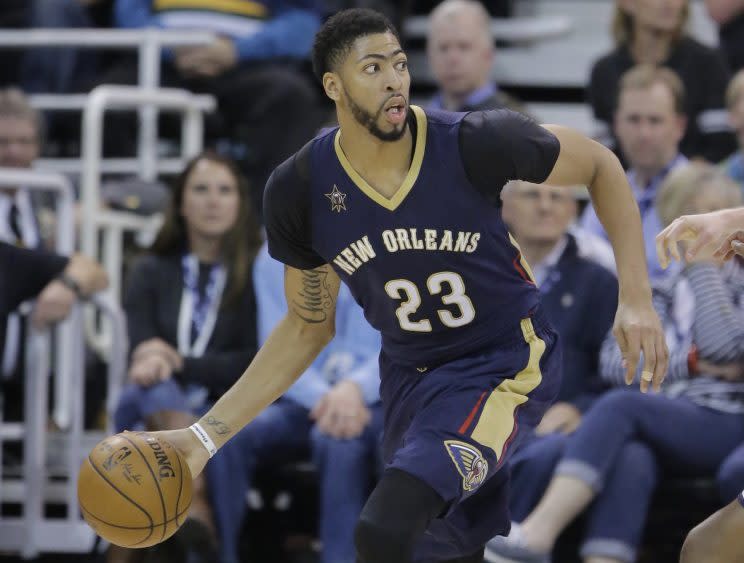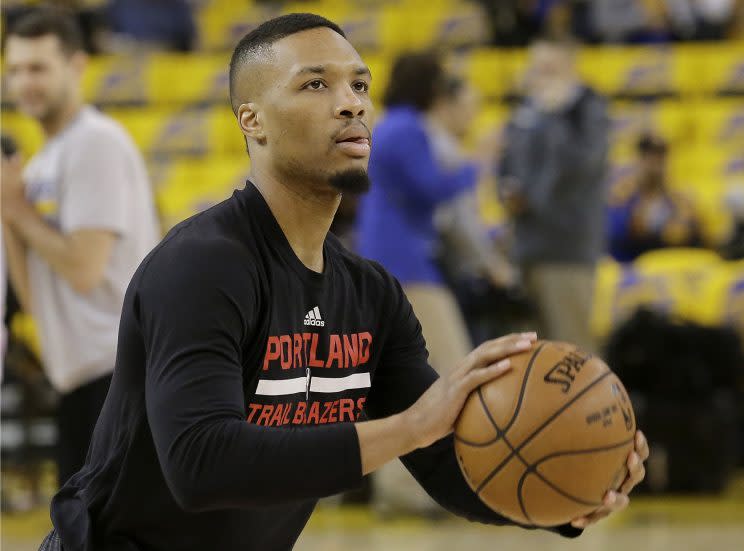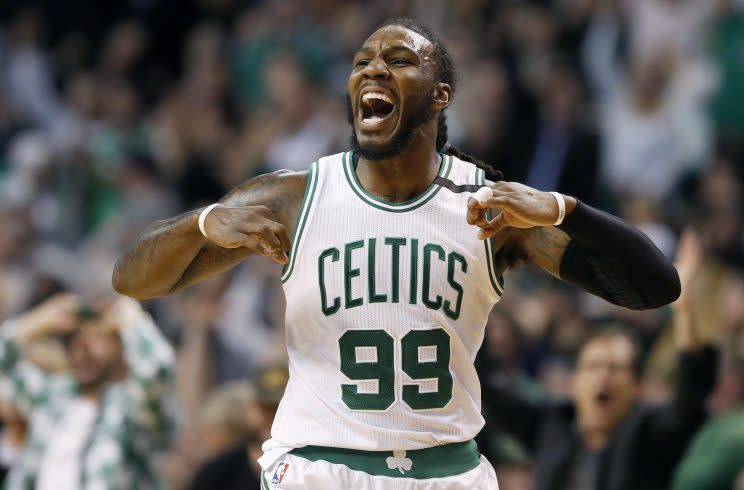After further review: Regrading the 2012 NBA draft

The NBA draft is an imperfect science.
General managers, coaches and scouts spend the entire year scouting and evaluating prospects, looking for the tiniest of edges. Truthfully, however, no one really knows.
Consider that some of the league’s best players — Draymond Green, Isaiah Thomas and Marc Gasol — were second-round picks. Better yet, consider Dallas’ duo of J.J. Barea and Wesley Matthews – neither player was drafted. The reality is that nobody — not even basketball’s brightest minds — is perfect.
This is the sheer beauty of exploring previous drafts. Five years is generally a large enough sample size to regrade a draft as players have usually morphed into what they will become. With that in mind, let’s re-examine the 2012 NBA draft. Naturally, there were some hits, but there were quite a few misses as well.
New Orleans: A
Anthony Davis was a home run as the top pick in the draft. At 24 years old, he has achieved unicorn status as one of the most dynamic players in the league. No big man runs the floor with such ease while also being able to face up and score from anywhere on the floor. Defensively, Davis’ dexterity and length — along with his rare timing as a shot-blocker – make him one of the most feared rim protectors in the league. As a result, we are talking about a future MVP. The Pelicans haven’t gotten a whole lot right over the past five years, but they certainly hit on Davis.
I didn’t understand the Austin Rivers pick (No. 10 overall) at the time and five years later, I still don’t understand it. Even during his most effective games during his lone season at Duke, Rivers was a ball-stopping isolation artist. To his credit, he has found a home as a backup combo guy who doesn’t hurt you defensively. Even still, the former prep phenom has never reached the three-assist mark and boasts lowly career averages from distance (34.5 percent) and the free-throw line (65.1 percent).
Charlotte: C
It’s not that Michael Kidd-Gilchrist is a bad player, it’s just that you’re not drafting someone second overall to be a glue guy. Defensively, let’s be clear: MKG is elite. He can guard four positions, which provides superb lineup flexibility — and it’s the reason why he’s earning $52 million.
Offensively though, it’s a different story. A severely flawed jump shot has prevented him from ever maximizing his awesome athleticism. Even as a 23-year-old, Kidd-Gilchrist has yet to develop any real creative capabilities offensively. Considering that Bradley Beal was on the board, it’s easy to question the pick.
Then Charlotte found a little value in Jeffery Taylor, whom it took with the first pick in the second round. Taylor, who has since gone on to play in Spain, provided a dose of versatility during his three-year stretch with the club.
Washington: A+
The silky Bradley Beal was compared to Ray Allen during the 2012 draft process. And while he hasn’t yet reached a Hall of Fame level, the third overall pick continues to flourish with the Wiz. The former Florida Gator — who turned 24 this week — has emerged as an elite offensive weapon alongside John Wall. A 40 percent 3-point shooter, Beal thrives in both up-tempo and half-court games. Beal’s immense skill set has expanded; he’s a facilitator now and flourishes in the pick-and-roll game. Last season, he posted career-highs in assists (3.5), free-throw attempts (4.4) and free-throw percentage (82.5 percent).
He could rebound and defend a bit more, but Beal was hands down the best combo man in the draft. And, although it took some time, there is real synergy between him and Wall. Beal is the willing — and ideal — Robin to Wall’s Batman.
Cleveland: C
Dion Waiters, drafted fourth overall, is coming off his best season. He averaged nearly 16 points on 39.5 percent 3-point shooting. Unfortunately for the Cavs, he did it for the Miami Heat. To be sure, Cleveland never really received top-five production from a guy they envisioned as an attacking, offensive menace. Despite last year’s anomaly, we know Waiters as a high-volume shooter with legendary defensive lapses. Remember too: Then-GM Chris Grant traded for 7-footer Tyler Zeller on draft night as well. During his two seasons with Cleveland, Zeller was an effective, part-time starter.
Sacramento: F
Thomas Robinson’s last quality season came in Lawrence, Kansas, where he was named Big 12 Player of the Year and earned first-team All-American honors. Sadly for the Kings, the fifth overall pick’s inability to extend the floor as a pick-and-pop guy made him a massive liability. Despite his rebounding prowess as a collegian, Robinson’s glass-eating ways never translated to the pro game. In five NBA seasons, he’s averaged 4.8 rebounds a game. It’s easy to critique now, but with future All-Star Andre Drummond still available, we can’t help not to.

Portland: A-
Damian Lillard, selected sixth overall, has become a monster in Portland. He’s a playmaking dynamo whose drives to the basket are lethal. Lillard is a superior pick-and-roll operator whose 3-point range is only topped by Steph Curry. Last year, the Weber State product scored a career-best 27 points per game while limiting his turnovers to a highly respectable 2.6. (Curry, as a reference, committed three per game.) Defensively, Lillard remains a work in progress — he gets lazy and gambles too often — but his offensive firepower has been a boon to Terry Stotts’ entire “flow” system.
The Blazers also found a microwave when they nabbed Will Barton in the second round. The only reason for the slightly reduced grade stems from the Meyers Leonard pick at No. 11. As good as Lillard — a two-time All-Star — Leonard has been equally poor. The 7-footer fell in love with the 3-pointer to a fault and never embraced his role as a rebounder or rim-runner.
Golden State: A+
This is how you construct a winner. Second-round selection Draymond Green is the ultimate Swiss Army knife and in many ways has been the impetus for the Warriors’ two championships. Not only can the two-time All-Star defend all five positions — hence being the 2017 Defensive Player of the Year — but his special playmaking ability in the half-court and in the open floor creates an assortment of open looks for Klay Thompson, Kevin Durant and Stephen Curry.
The Dubs also grabbed Harrison Barnes with the seventh overall pick. He wasn’t perfect, but as a rugged defender and quality offensive option, Barnes — who signed with Dallas last summer — was a high-level wing who afforded coach Steve Kerr the luxury of playing him as a small-ball four as well. Also, taking Festus Ezeli at No. 30 can’t be overlooked either. The hefty center was a valuable deep-rotation guy during the Warriors’ title run in 2015.
Toronto: B-
Terrence Ross was an early member of the league’s three-and-D movement. A super athletic but limited wing, the 6-foot-7 Ross has retained value because of his ability to spread the floor and guard multiple positions. Five years later, however, it’s obvious Toronto overdrafted him with the eighth pick. The Raptors sent him to Orlando during the February trade deadline.
Detroit: A+
Andre Drummond left UConn as a project and has since emerged as one of the league’s premier shot-blockers, rebounders and finishers — inching closer to the absurd hype he garnered as a high school senior. Just 23 years old, the 6-foot-11 center uses his tremendous athleticism to run the floor and protect the rim, but he doesn’t possess a definitive low-post game or deft touch.
Detroit gambled on him with the ninth pick — questions persisted about a perceived lack of motivation and his durability — but Drummond has become the best true big man of this draft.
The Pistons also hit it big with Khris Middleton. The smooth-shooting wing has since gone on to greener pastures with the Bucks, but give Detroit credit for finding a real gem with the 39th pick.
Oklahoma City: D+
Jeremy Lamb, at the very least, should have been Terrence Ross lite. Lamb was the key to the James Harden trade for GM Sam Presti. The No. 12 overall pick was 6-foot-5 with a 6-foot-10 wingspan and could jump 38.5 inches. But Lamb’s lack of assertiveness and inability to consistently make threes (32.4 percent career 3-point shooter) has made him an expendable wing. He’s salvaged his career to an extent in Charlotte, but Lamb has been a disappointing lottery pick — more of a specialist than anything else.
Speaking of the lottery, Oklahoma City hoped to hit just that when it drafted Baylor forward Perry Jones at No 27. He was a classic low-floor, high-ceiling talent. A high school megastar, Jones’ pro career — much like his college one — never materialized the way many had hoped. A shaky jumper yielded poor results and he lacked toughness. After three middling seasons with the Thunder, Jones hasn’t played in the NBA since 2015.
Phoenix: F
The Suns wasted their one pick in 2012 on Kendall Marshall, a sluggish point guard who is currently with the NBA development league’s Reno Bighorns. Despite his pedigree as a McDonald’s All-American and Bob Cousy Award winner (given annually to the nation’s best college point guard), Marshall’s pick-and-roll prowess never translated as a pro. In 160 career games, the former North Carolina Tar Heel managed a meager 5-to-2 assist-to-turnover ratio.
Milwaukee: A-
Milwaukee found tangible value at No. 14 with another former Tar Heel in gifted big man John Henson. Henson’s incredible length (he’s 6-11 with a 7-5 wingspan) has made him an effective, if not dominant, shot-blocker. As a whole, Henson is a plus defender. Moreover, he has developed into a terrific roll man, which is why the team views him as part of its long-term program. Does he post up? Not anymore, and that’s just fine with coach Jason Kidd.

Orlando: B+
Maurice Harkless has long moved on from Orlando, but he was well worth the No. 15 pick in a draft that was lacking in talent at the top. The one-and-done St. John’s product has carved out a nice career while expanding his game. With Portland this past season, he averaged a career-high 10 points on 35.1 percent 3-point shooting. The rangy, 6-9 Harkless also defends well. At his best, he’s a quality reserve on a winning team, which represents value in the middle of the first round.
Andrew Nicholson was a solid get at No. 19. As a four-year member of the Magic, he spot-started and provided some scoring punch.
The Magic get bumped up a letter grade for finding a second-round gem in Norfolk State’s Kyle O’Quinn. O’Quinn — who agreed to a four-year, $16 million sign-and-trade with the Knicks in 2015 — is an ideal bottom-roster guy who can rebound and he’s even become a decent midrange shooter.
Houston: F
Royce White enjoyed a fantastic college career at Iowa State, but couldn’t play in the NBA because of a debilitating anxiety disorder. When Houston drafted him at No. 16, GM Daryl Morey probably envisioned a Draymond Green type: A rugged but highly skilled weapon who could impact the game on multiple levels. One bit of good news on White: He was recently named MVP of Canada’s top professional league. At 26 years old, perhaps a comeback is in order.
Morey, to a degree, made up for the gaffe by getting Kentucky’s Terrence Jones at No. 18. Jones — still just 25 — provided a dose of versatility on both ends of the floor during a four-year stint with the Rockets.
Denver: A
Evan Fournier is precisely the type of guy you’re hoping for at No. 20: a consistent 3-point shooter and reliable third or fourth scoring option. He’s hardly sensational but highly productive. While he served as a reserve in Denver, the Frenchman has since gone on to become an extremely valuable starter in Orlando. He posted career highs in scoring (17.2 points), assists (three per game) and minutes (32.9) this past season. In the second round, the Nuggets whiffed on Baylor freshman Quincy Miller, who played just 69 career games.
Boston: B-
To his credit, Jared Sullinger put together a really nice run in Boston. Despite question marks about his athleticism and skill, the 21st pick in the 2012 draft developed into a plus starter. He worked diligently on his midrange game and used his soft hands to gather the ball and finish plays in the paint. Fab Melo, whom the team selected with the 22nd pick, died in his native Brazil at 26. He was an ineffective NBA center who was never able to get into tip-top shape and harness his rare size.
Atlanta: B-
John Jenkins, selected 23rd overall, is a tremendous 3-point shooter who enjoyed a bit of success during his three seasons with the Hawks. The former Vanderbilt guard is able to overcome his limited creativity and lack of lateral ability because of how well he shoots it. His best season as a pro came as a rookie, when he connected on 38 percent of his 3-pointers in 61 games. In the right system, Jenkins — a high-character guy — can still be a serviceable spacer off the bench.
The jewel for Atlanta was second-rounder Mike Scott. A prototypical pick-and-pop big, Scott has considerably overachieved but has struggled with some injury woes.
Memphis: C
It would have behooved Tony Wroten to stay another season at school in Washington. Memphis, who nabbed the talented lefty triggerman with the 25th overall pick, grew frustrated with his inability to develop any sort of jump shot. After a resurgence with Philadelphia during the 2014-15 season, when he averaged 16.9 points a game, Wroten’s NBA career has perhaps come to an end. He played just eight in 2015-16 and failed to secure a contract this past season.
Indiana: B+
Late first-round picks such as Miles Plumlee might not move the needle for fans, but they are necessary and hard to find. The “first” Plumlee brother has carved out a productive career and is now with Atlanta as part of the Dwight Howard trade. He is a reliable, hard-nosed 7-footer who can give teams 10 minutes a night. But he’s not the highly expandable big man many figured he would be.
Chicago: F
Undersized guards without real perimeter games struggle at this level. Unfortunately for Bulls execs Gar Forman and John Paxson, Marquis Teague was just that. After winning a national championship alongside Anthony Davis at Kentucky, Teague left Lexington. Chicago rewarded the Indianapolis native with a first-round draft choice, only to discover what many of us already knew: Teague — who couldn’t offset his shooting issues by excelling at anything else — was not an NBA player. He hasn’t played in the league since 2014.

Dallas: A+
Dallas clearly saw something in Jae Crowder that the rest of the league didn’t. While the bulk of Crowder’s success has come with the Celtics, the Mavs deserve plenty of credit for finding gold late in the second round. Crowder — whom they acquired on draft night from the Cavs — can guard, rebound, shoot and drive. If there were a 2012 re-draft, he wouldn’t last past the top 10.
Dallas whiffed badly on center Bernard James, who was acquired in the Crowder deal. James, the 33rd pick in 2012, never established himself as a good enough shot-blocker or rebounder. He’s been out of the NBA for two seasons, as has Jared Cunningham, whom the team also picked up in a draft-day trade.
Philadelphia: F
This is the “pre-Process” era, when Philadelphia was rudderless and lacking any real identity. The team traded a lottery-protected pick to Miami for the rights to center Arnett Moultrie, who was drafted 27th. His career never gained traction. The Mississippi State product last played an NBA game in 2014.
L.A. Lakers: A
He wasn’t the most skilled, but center Robert Sacre enjoyed a nice career for being the NBA draft’s Mr. Irrelevant. The Gonzaga product averaged more than four points and three rebounds during a four-year stretch in Los Angeles.
Brooklyn: Incomplete
Former Kansas star Tyshawn Taylor didn’t work out for the Nets after they traded with Portland to get him. The 41st pick averaged eight minutes per game during his two-year NBA stint.
New York: Incomplete
The Knicks took Greek forward Kostas Papanikolaou with the 48th pick. Papanikolaou played two NBA seasons, neither with the Knicks.
San Antonio: Incomplete
San Antonio selected Missouri point guard Marcus Denmon with the 59th pick. Denmon never played an NBA game.
L.A. Clippers: Incomplete
The Clips went draft-and-stash with the 53rd pick. Turkish big man Furkan Aldemir never came to the NBA, however.
Minnesota: Incomplete
With the 58th pick, then-GM David Kahn — running his final draft for the Timberwolves — took a flyer on Purdue forward Robbie Hummel. Hummel was a terrific college player, but endured a series of injuries that ended his NBA career after just two seasons.
Utah: Incomplete
It’s hard to get down on a team for the 47th pick. Utah gambled with a pretty talented shooting guard in Tennessee Tech’s Kevin Murphy. In his lone NBA season, Murphy played in just 17 games and averaged .9 points.
Miami: Incomplete
Miami’s lone draft pick was Arnett Moultrie, whom Pat Riley dealt to Philadelphia for the rights to center Justin Hamilton — who had a very limited role with Maimi but has since found a home in Brooklyn — and a future No. 1.
More from The Vertical:
• The Vertical’s Fab 50 Free Agents
• Masai Ujiri could fix Knicks’ mess, but competent moves aren’t their style
• Clippers agree to trade Chris Paul to Rockets
Popular video from The Vertical:


